 |
Scott Rowe, a finance graduate student and assistant professor of naval science, founded
Rodopto, a drone-based agricultural services company, to provide small- and mid-size
farms with seeding services and precision applications of fertilizer and pesticides.
|
For as long as he can remember, Scott Rowe has been passionate about two things –
flying and farming. So, it was only natural for Rowe to combine those two life-long
passions as he begins his transition from the Naval service.
Rodopto, the drone-based agricultural services company he recently founded, is dedicated
to leveraging the latest in drone technologies and advanced analytics to provide efficient,
cost-effective, and sustainable agricultural services to underserved segments of
the farming industry.
The company’s customer value proposition is to provide small and medium sized farms
with seeding services and precision applications of fertilizer, fungicides, pesticides,
and herbicides that offer more precise and more timely coverage using less material
than traditional methods.
The bottom line for farmers is higher crop yields at substantially lower cost.
Rowe, assistant professor of Naval Science at Auburn and Master of Science in Finance candidate at the Harbert College of Business, won second place in Auburn’s annual Tiger Cage Student Business Idea Competition this past March 31st and is well on its way to
demonstrating Rodopto’s proof-of-concept – thanks in part to his Tiger Cage winnings.
How He Got Here
Rowe’s professional journey began 10 years ago at the United States Naval Academy,
where he earned a B.S. in Computer Science. He went on to fly both fixed-wing and
rotary-wing aircraft.
After serving as a helicopter pilot and instructor pilot in the Navy, he came to Auburn
in the fall of 2021 as a Naval ROTC instructor, tasked with mentoring the next generation
of Naval Officers.
“Flying – whether it is sitting at the controls in an actual aircraft or as the on
the-ground pilot of a drone – requires a certain kind of high-level, intense awareness,”
says Rowe. “If you’re not passionate about flying, you wouldn’t fly.”
“As a professional aviator, I will tell you that one of the most incredible things
I’ve ever seen is an F-18 landing on the deck of an aircraft carrier – talk about
a huge (but well managed) risk!
The second most impressive thing Rowe says he’s seen is a crop duster flying low across
a farmer’s field. “Obviously, that’s very dangerous as well, and equally amazing from
my perspective. There’s a lot of risk involved there, too.”
But as cool as that kind of ‘Top Gun’ landing is to watch, it’s all the things going
on behind the scenes that fascinate me even more – the uncool, unsexy parts, the critical
aspects of the mission that take place before the aircraft ever leaves the ground
and continues long after it has landed.”
Whether it’s supporting naval operations across the globe or skimming across a farmer’s
field, Rowe maintains it all comes down to risk management. “In each of these two
situations,” he says, “mission planning – everything that goes on before takeoff,
during flight, upon landing, and afterwards – is designed to take as much risk as
possible out of an inherently risky proposition.”
When it comes to providing agricultural services such as aerial application in the
not-too-distant-future, the question is, “how can we provide these services while
taking on the least amount of risk? Going forward, that likely means a shift to unmanned
aerial vehicles.
Where He’s Heading
Rowe is taking all the experience he’s accumulated as a pilot and flight instructor
and applying that knowledge and insight to helping farmers take advantage of the latest
in drone technology to help boost their crop yields while reducing their overall cost
of operation.
Rowe’s vision for the future of farming is bright. His vision encompasses a scenario
that sees farmers of all shapes and sizes leveraging the latest advancements in technology.
“When you drive through Alabama 20 years from now, you’re going to see automated tractors
plowing fields of corn, wheat and other essential crops,” says Rowe. “You’re going
to see drones flying overhead surveying and applying necessary ingredients for crop
growth and disease abatement. And what you won’t see – but will be working behind
the scenes – is advanced analytics managing the effectiveness of all this automation.”
The challenge, as Rowe sees it, is finding ways for small farmers to realize the benefits
of ever-evolving technology and automation that increasingly larger farms will be
able to utilize on a massive scale. How can they compete – or even survive – in an
environment that favors economies of scale? Farmers – especially small farmers – operate
on thin margins to begin with, making it imperative they manage inputs efficiently
to keep costs as low as possible in order to maximize profit.
Precision is Key
One of the key differentiators between crop dusters and drone-based approaches is
the ability of drones to deliver nutrients such as nitrogen fertilizers and apply
agricultural chemicals precisely where and when they are needed most. This becomes
important when you consider the edges of fields, areas not easily reached by crop
dusters. For small farmers, those sections represent a much higher percentage of crops
than at larger farms.
Crop dusters are required by the Federal Aviation Administration (FAA) to stay at least 500 feet from roads and structures, severely limiting their
ability to reach crops on the edges. Drones, on the other hand, are allowed to fly
much closer to roads and buildings – as close as 100 feet.
“This means drones offer a much broader delivery option for the entire field, not
just the center rows,” says Rowe. “That’s the first advantage – a greater footprint.”
“The second advantage of drone-based crop management goes beyond geographic coverage.
Drones can fly lower than those fixed wing aircraft, meaning they can deliver nutrients
and herbicides more precisely with much less of these costly materials needed for
a given area. The cost of applied materials is significant, and this higher level
of efficiency drops right to the bottom line for the small farmer.”
Precision also brings a higher level of selectivity, says Rowe – the third advantage
of a drone-based approach.
“Different areas of a field need different levels of application, whether it is nutrients
or disease management chemicals. Bulk application leaves some areas needing more while
other areas become over-saturated. Rodopto is leveraging the value of precise crop
surveillance data to target and deliver equally precise materials application.”
Finally, higher precision application is less harmful to the environment, making it
a more sustainable option. Consumer scrutiny of the chemicals used to grow their food
is a critical – and growing – concern for farmers, whether they label their crops
“organic” or not. “And it’s not just pesticides,” notes Rowe.
“Just look at red tide, the harmful algae blooms occurring every year in downstream areas like Florida’s
coastal waters that threaten wildlife and beaches alike. That’s the result of the
run-off of over-fertilization well up-stream that finds its way through streams and
rivers and into the Atlantic ocean and gulf waters. Overspray – ‘collateral damage’
as we call it in military terms – is a huge issue.”
Sweet Home Alabama
Rowe is taking a targeted market approach to developing his company’s products, services
and value proposition, beginning with the needs of small farmers right here in Alabama.
“The value of all the crops grown in Alabama is roughly $1.2 billion annually grown
on an estimated 2.8 million acres.” notes Rowe. “That’s a sizable overall market.
Alabama farmers spend approximately $90 million a year on crop application services,
and we’re addressing the portion of that market represented by small farms – those
under 200 acres.”
It turns out that small farms in Alabama represent 75% of all farms in the state.
The United States Department of Agriculture’s latest statistics show that there were 30,377 farms under 180 acres operating in Alabama in 2017, the
latest year numbers were reported.
“How can we help deliver the advantages of drone technology and advanced analytics
– including AI – to an important market segment that could benefit tremendously but
knows very little about how to make that happen? How can we make adoption of new ideas
and approaches easier for them? More efficient? Less cost-prohibitive? In the end,
Rodopto is all about helping them overcome these challenges.”
Rowe credits Auburn University – and the New Venture Accelerator in particular – with
providing critical components of his company’s success to date, citing both the expertise
he’s drawn on from his mentor within the College of Agriculture, Max Runge, and the
mentorship and start-up services of the NVA.
“I couldn’t have placed as high as I did in this year’s Tiger Cage finals without
the incredible Auburn Family. The combination of engineering, flight, agriculture,
and business expertise right here at Auburn puts me in a great position to succeed.
Without Jennifer Nay as my entrepreneur coach at the NVA, there’s no way I would have
been able to present the potential of Rodopto to contest judges and potential investors
as clearly and succinctly as I did. The hours upon hours she spent with me refining
my pitch alone must have been challenging for her, but trust me, I appreciate it immensely.”
The Path Forward
Rowe is focusing on three things as he moves into the next stage of Rodopto’s development.
- He’s modifying the drone he purchased using his Tiger Cage winnings into his first
prototype, which he intends to use in practical trials with local Alabama farmers.
- He’s working with the FAA to secure the exemptions he needs to be able to fly multiple
drones across a given field – “swarming,” as it is called – which will expand the
effectiveness of Rodopto’s approach over the longer term.
- He’s looking for partners who can help accelerate the adoption of his drone-based
approach, be they major agricultural equipment suppliers looking to leverage the latest
technology, small farming organizations, or agriculture-focused investors seeking
to participate in what Rowe sees as a potentially lucrative, fast-growing market.
“I know there’s a tremendous need. I know there are promising solutions we can bring
to the table. We’ve moved the needle a little bit so far, and interest is growing.
What I’m looking for now is others who know more than I do about how to help make
all of this happen.”
To learn more about Rodopto contact Scott Rowe.
Learn more about the New Venture Accelerator.

 Degrees & Programs
Degrees & Programs
 Faculty & Staff
Faculty & Staff
 Career Development
Career Development
 Recruiters & Industry
Recruiters & Industry





